Mixed Messages: Photographs can set you off.
April 26, 2016
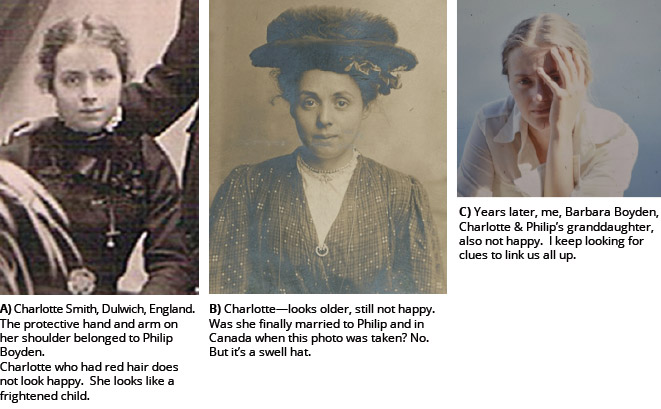
These three photographs called out to me from the jumble of photos dumped into old satin covered chocolate boxes, wooden cigar boxes and carousels holding almost a thousand 35mm slides. Don’t look—toss? Just a quick peek? No such thing. Not after Aunt Rose blabbed.
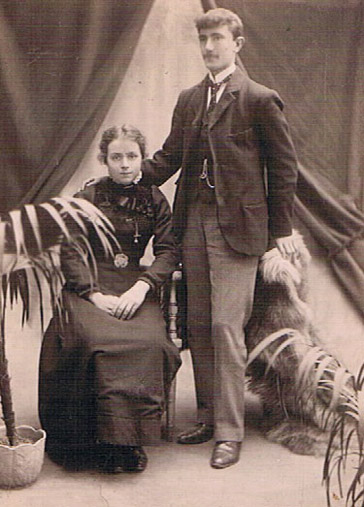 The first picture (A.) is a close-up of Charlotte from this English studio photograph of my paternal grandparents, Charlotte & Philip Boyden.
The first picture (A.) is a close-up of Charlotte from this English studio photograph of my paternal grandparents, Charlotte & Philip Boyden.
This must have been taken before Charlotte and Philip married—Charlotte is not wearing a wedding band. Was this photo taken before Philip went on the lam to Canada saying, “Not me. I didn’t get her pregnant.”?
Left behind in England, pregnant Charlotte still did not look happy (photo B.) Sometimes, even a frilly hat isn’t enough. Judging from the supposed 12-year difference between my Uncle Fred and my father, Charlotte kept house for her father for 12 years.
Aunt Rose, remember her? Well Aunt Rose told me it was rumoured that Charlotte’s mother had been put in an insane asylum. Philip’s brother William had had enough. He dragged Philip back to England and forced him to marry Charlotte who had won her paternity suit. Yup, paternity suit. Charlotte wasn’t just a pretty face.
However, William hadn’t made his decision until he was pushed. Charlotte’s father died, and she and Fred had no place to live. Charlotte appears to have not just another hat, but a wedding band in this photo. Maybe she had this photo taken because she was off to Canada with her husband and child, who was no longer a baby and still not accepted by Philip as his son. And never was.
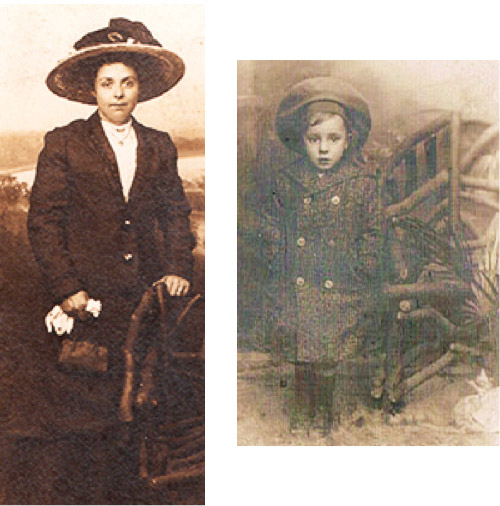
Philip and Charlotte were married Christmas Day, 1911 in England. They returned to Toronto together and squeaked through the Depression.
*****
In Canada, Philip’s brother William worked as a chauffeur for Sir Byron Edmund Walker, the co-founder of the Royal Ontario Museum. La-de-dah you say. Well, the connection provided roast beef dinners for the rest of the Boydens—the unemployed Boydens.
According to my mother, Charlotte had to work as a cleaning lady because Philip only worked in the summers and spent winters on the dole. My mother didn’t like Philip, her father-in-law, and she wasn’t thrilled with Uncle Fred either.
My grown up Uncle Fred had the Boyden long upper lip and double chin just like the other Boyden men, especially Uncle William. This is why I found the paternity suit funny and Philip’s refusal to accept Fred as his son so unbelievable. Fred married and presented Charlotte and Philip with their first grandchild, Beryl. I see a shimmer of my father Eric’s face in his cousin Beryl’s.
*****
Fred went off to win the war in Europe. He had a fine time. Here he’s showing a younger Queen mum a cooking pot.

That’s it for the photographs of Uncle Fred. The day Fred returned to Toronto from WW2, Charlotte decorated the house – inside and out.
“WELCOME HOME FRED”.
The banner fluttered for all the neighbours to know that her Fred would soon be home.
My parents went to pick up Fred from the train station and once again a dreadful family secret crept out. Fred told my parents that he wasn’t going home with them to see his mother and father, and he was not returning to his wife. He had met another woman.
It was a long silent Fred-less drive back to the east end of Toronto to break the news to Charlotte.
My mother said Charlotte’s heart was broken and her health went downhill from there. Charlotte developed diabetes and died within a few years—complications of gangrene in her foot. I was about three years old and don’t remember her. It was Beryl who told me Charlotte was a redhead and used to have Beryl brush her hair when she visited. Beryl’s mother seldom allowed visits. Uncle Fred had a new wife, a new daughter, and was totally shut out by Philip.
*****
Back, way back, to photo A. In this one, Charlotte could have been my sister Debby who died in her 50s of complications of her diabetes. And my sister experienced debilitating bouts of bi-polar disorder (manic depression). So I’ve wondered—just what put Charlotte’s mother into a hospital for the mentally ill?
There’s a theory that mood disorders are hereditary. Here’s my not-so-wild theory: the depression and mania came from my father’s side of the family. Circumstances can enable or increase mood disorders. It’s probably what Charlotte’s mother had, what Charlotte had, what Debby had, and what pushed my father into depression when my sister Debby died.
Now, me-me-me. When I first saw the photograph of me (photo C.), I thought it was my sister Debby. But no, it is me wearing my yellow shirt purchased in England and that’s an example of true sibling rivalry. I would never have allowed my sister to borrow my yellow shirt. The photo was taken at the cottage around the time I was, well, deserted. My father, Eric took the photo. Did he wonder what in god’s name was wrong with me? Probably. Eric was the sensitive one in my parent’s marriage.
Even in the end, there were secrets and disapproving frowns. I met Fred’s daughter Beryl through a happenstance phone call. She recognized my name and we re-connected our family—without Uncle Fred. We had a swell time at our first dinner, sitting around the gene pool, trying to figure out who was who. “Hey you’ve got the exact same eyes as Granddad. And his moustache.” You know, that kind of stuff. (If you’re trying to work it out, Beryl’s son looked exactly like my grandfather, Philip.)
Beryl’s father Fred went into hospital and my parents insisted that Beryl should know, but Beryl had moved. How did I track her down? Through our happenstance phone call.
At the hospital, Beryl told the nurse she was Fred’s daughter, and went in. Daughter Number Two did the same thing and it got awkward. No one on our side of the divide cared, so Beryl made peace with her father and said her goodbyes.
When you look at old photographs, you squint, pass them in and out of the light, or look for other photos taken about the same time. What you see depends on what you know, or think you know, and how you arrange the photographs. And what your Aunt Rose told you. Are the people in the old photos happy? Frightened? Sad? Maybe the camera doesn’t lie. The people in my family photos are steeped in mixed messages. Enigmas.
RANDOM WHO’S WHO
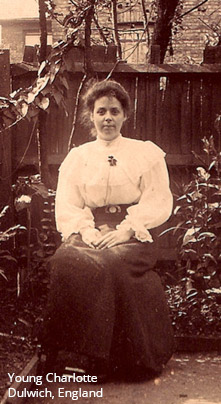
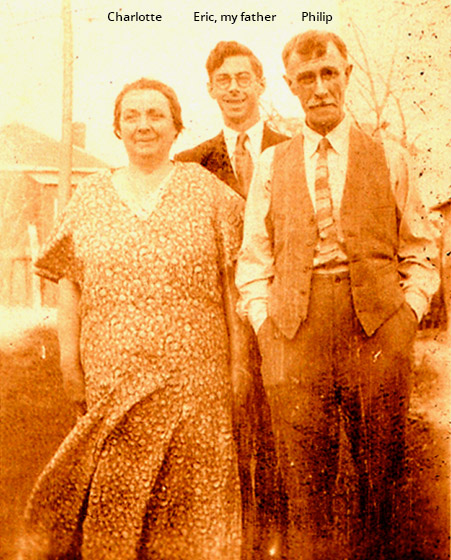
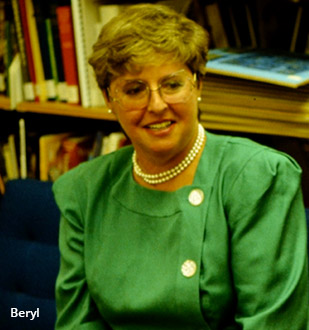



All I can say is….I look forward to meeting you in person and telling stories.
Wow. Great photos. Great detective work. Family secrets and family stories. I’ve been delving into my own and my wife’s for the past three years and still haven’t come out the other side. Lots of love found and lost, feuds among sisters, suicides, murders, and institutionalizations, feuds among brothers, medical disasters, ptsds especially after the war, drinking and philandering and incest, and of course in her case throw in torture and slaughter by the original inhabitants of our great country and in my case throw in pogroms and the Holocaust. I love the way you have told this story. Now if I can just learn from it when I try to write my own.
I am enjoying your blog. Perhaps because my own family history is rife
with lies and abandonment and silliness. I found out not very long ago that my disappeared father died in Pasadena, California at age 74. This freaked out my sister who lives there and it struck her that he may have pumped gas for her or sold her groceries. Life is weird!